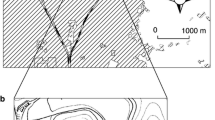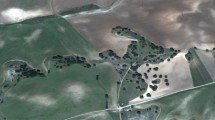Abstract
Quercus crispula (=Q. mongolica var. grosseserrata) is the predominant tree species in cool temperate, mixed broadleaf/conifer forests in northern Japan. We compared 11 years of data on acorn production in a population of Q. crispula, with data on seed-insect populations, to try to answer the following questions: (1) Does Q. crispula show a regular pattern of masting? (2) How long do principal seed predators remain in diapause? (3) How do the seed predators affect the pattern of predator satiation? Q. crispula showed a tendency to alternate bearing, with significant synchrony between individual trees. The principal acorn-feeding insects (Curculio spp. weevils), which infested 25%–70% of matured acorns, generally exhibited a prolonged diapause of 2 years. No significant negative relationship was found between the rate of injury by the weevils and the density of mature acorns, indicating that simple predator satiation fails due to the synchrony of the life-cycle of acorn-feeding insects and the periodical production of acorns. However, the rate of injury by the weevils was negatively correlated with the relative abundance of mature acorns to the number of weevil larvae that had matured 2 years previously. Thus, the proportion of sound acorns notably increased in a rich crop after a disturbance in alternate bearing. Prolonged diapause of specific seed predators is critical in determining the peak year of sound-seed production.






Similar content being viewed by others
References
Brezner J (1960) Biology, ecology, and taxonomy of insects infesting acorns. Univ Mo Agr Exp Sta Res Bull 726:1–40
Crawley MJ, Long CR (1995) Alternate bearing, predator satiation and seedling recruitment in Quercus robur L. J Ecol 83:683–696
Fukumoto H, Kajimura H (2001) Guild structures of seed insects in relation to acorn development in two oak species. Ecol Res 16:145–155
Hanski I (1988) Four kinds of extra long diapause in insects: a review of theory and observations. Ann Zool Fenn 25:37–53
Harris MK, Chung CS, Jackman JA (1996) Masting and pacan interaction with insectan predehiscent nut feeders. Environ Entomol 25:1068–1076
Horikawa Y (1972) Atlas of the Japanese flora. Gakken, Tokyo
Houle G (1999) Mast seeding in Abies balsamea, Acer saccharum and Betula alleghaniensis in an old growth, cold temperate forest of north-eastern North America. J Ecol 87:413–422
Imada M, Nakai T, Nakamura T, Mabuchi T, Takahashi Y (1990) Acorn dispersal in natural stands of mizunara (Quercus mongolica var. grosseserrata) for twenty years. J Jpn For Soc 72:426–430
Janzen DH (1971) Seed predation by animals. Annu Rev Ecol Syst 2:465–492
Kanazawa Y (1975) Production, dispersal and germination of acorns in natural stands of Quercus crispula—a preliminary report. J Jpn For Soc 57:209–214
Kanazawa Y (1982) Some analyses of the reproduction process of a Quercus crispula Blume population in Kikko. I. A record of acorn dispersal and seedling establishment for several years at three natural stands. Jpn J Ecol 32:325–331
Kelly D (1994) The evolutionary ecology of mast seeding. Trends Ecol Evol 9:465–470
Kelly D, Sullivan JJ (1997) Quantifying the benefits of mast seeding on predation satiation and wind pollination in Chionochloa pallens (Poaceae). Oikos 78:143–150
Kikuzawa K (1991) Mizunara (Quercus crispula). Koshunai Q 85:23–25
Koenig WD, Knops JM (1998) Scale of mast-seeding and tree-ring growth. Nature 396:225–226
Koenig WD, Mumme RL, Carmen WJ, Stanback MT (1994) Acorn production by oaks in central coastal California: variation within and among years. Ecology 75:99–109
Maeto K (1993) Acorn insects of Quercus mongolica var. grosseserrata in the Hitsujigaoka natural forest, Hokkaido—life-history of the principal species and their impacts on seed viability. Trans Mtg Hokkaido Br Jpn For Soc 41:88–90
Maeto K (1995) Relationships between size and mortality of Quercus mongolica var. grosseserrata acorns due to pre-dispersal infestation by frugivorous insects. J Jpn For Soc 77:213–219
Manu F, Debouzie D (1993) Coin-flipping plasticity and prolonged diapause in insects: example of the chestnut weevil Curculio elephas (Coleoptera: Curculionidae). Oecologia 93:367–373
Mattson WJ (1971) Relationship between cone crop size and cone damage by insects in red pine seed-production areas. Can Entomol 103:617–621
Morimoto K (1981) On some Japanese Curculioninae (Coleoptera: Curculionidae). Esakia 17:109–130
Papp J, Maeto K (1992) Triaspis curculiovorus sp. n. (Hymenoptera, Braconidae) from Japan, parasitizing acorn weevils. Jpn J Entomol 60:797–804
Shibata M, Tanaka H, Nakashizuka T (1998) Causes and consequences of mast seed production of four co-occurring Carpinus species in Japan. Ecology 79:54–64
Shibata M, Tanaka H, Iida S, Abe S, Masaki T, Niiyama K, Nakashizuka T (2002) Synchronized annual seed production by 16 principal tree species in a temperate deciduous forest, Japan. Ecology 83:1727–1742
Silvertown JW (1980) The evolutionary ecology of mast seeding in trees. Biol J Linn Soc 14:235–250
Sokal RR, Rohlf FJ (1995) Biometry, 3rd edn. Freeman, New York
Sork VL, Bramble J, Sexton O (1993) Ecology of mast-fruiting in three species of North American deciduous oaks. Ecology 74:528–541
StatSoft (1998) STATISTICA 5.1 for Windows. Tulka, Okla
Ueda K (2000) Pre- and post-dispersal damage to the acorns of two oak species (Quercus serrata Thunb. and Q. mongolica Fischer) in a species-rich deciduous forest. J For Res 5:169–174
Acknowledgements
We thank Simon Lawson, Naoto Kamata and Mitsue Shibata for commenting on an earlier draft of the manuscript, and Katsura Morimoto and Furumi Komai for the identification of weevils and moths, respectively. Our thanks are also due to Chikara Koizumi and Kenji Fukuyama for their continuous encouragement. This study was supported in part by a grant-in-aid (Bio Cosmos Program) from the Japan Ministry of Agriculture, Forestry and Fisheries.
Author information
Authors and Affiliations
Corresponding author
Rights and permissions
About this article
Cite this article
Maeto, K., Ozaki, K. Prolonged diapause of specialist seed-feeders makes predator satiation unstable in masting of Quercus crispula . Oecologia 137, 392–398 (2003). https://doi.org/10.1007/s00442-003-1381-6
Received:
Accepted:
Published:
Issue Date:
DOI: https://doi.org/10.1007/s00442-003-1381-6




